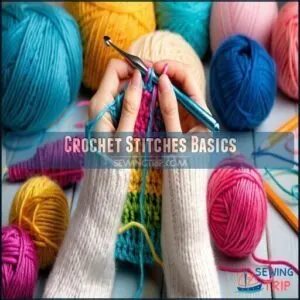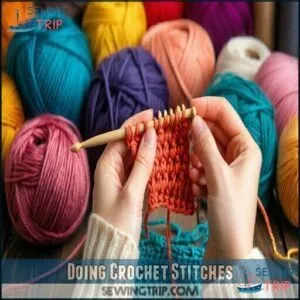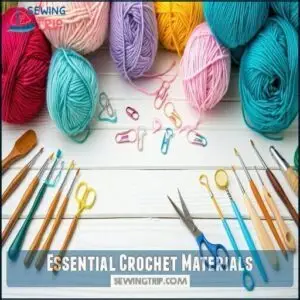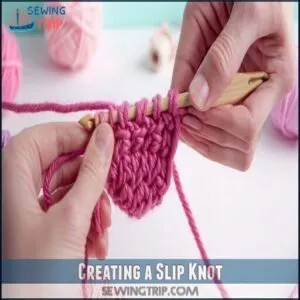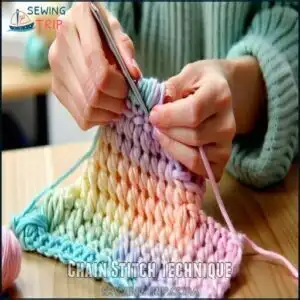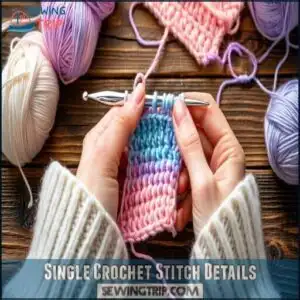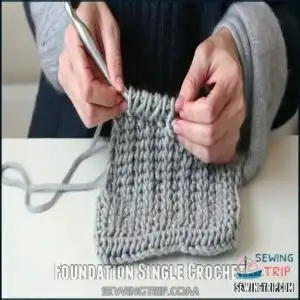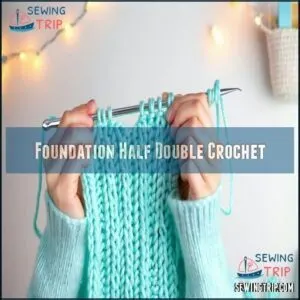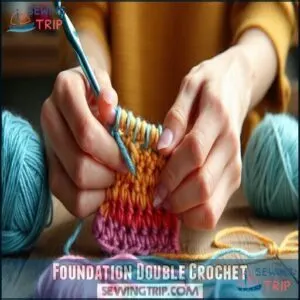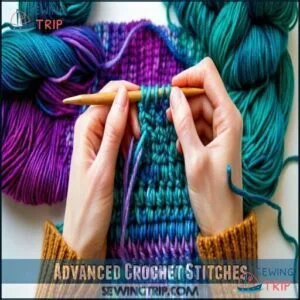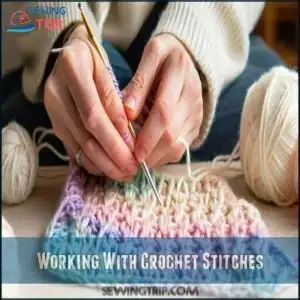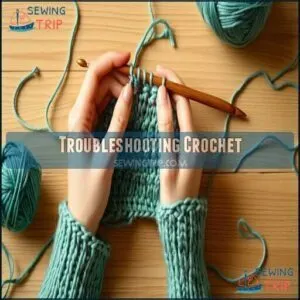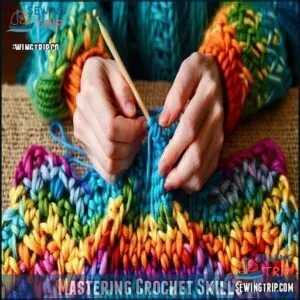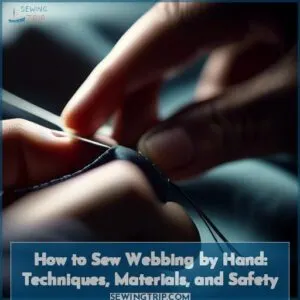This site is supported by our readers. We may earn a commission, at no cost to you, if you purchase through links.
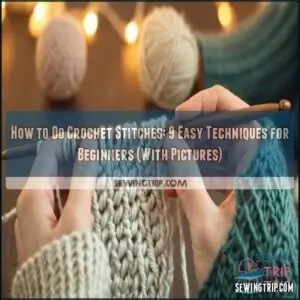
Move on to single crochet (the building block stitch) by inserting your hook, yarn over, and pulling through loops. For double crochet, you’ll yarn over first, creating taller, airier stitches. Half double crochet sits right in between.
Hold your hook like a pencil or knife—whatever feels comfortable—and maintain consistent tension. Remember, everyone’s first stitches look like a tangled mess, but stick with it. Those fancy lace patterns aren’t as complicated as they appear, and with practice, you’ll master the single crochet and yarn over techniques.
Table Of Contents
Key Takeaways
- You’ll master crochet basics by starting with a slip knot and chain stitch, then progressing to single crochet, half double crochet, and double crochet—each creating different fabric densities and textures.
- You’ll need the right tools to succeed: appropriate hook sizes that match your yarn weight, quality yarn suited to your project type, and accessories like stitch markers and yarn needles.
- You’ll improve faster by maintaining consistent tension throughout your work, counting stitches regularly, and using foundation stitches for stretchier edges on projects like scarves and blankets.
- You’ll encounter common problems like dropped stitches or uneven tension, but with practice and troubleshooting techniques, these issues will become easier to fix as your hand-eye coordination develops, and you’ll learn to create projects with different fabric densities.
Crochet Stitches Basics
You’ll master the basic crochet stitches faster than you can untangle your yarn with these simple, step-by-step techniques.
From chain stitches that start every project to double crochets that build your fabric, these fundamental moves will quickly become second nature as you practice, and you will find that chain stitches are essential to every project.
Chain Stitch Fundamentals
The foundation of crochet begins with mastering chain stitch fundamentals. You’ll use this essential technique to start nearly every project.
Chain stitches create the backbone for your work.
- Start with a slip knot on your hook
- Yarn over and pull through to create each chain
- Maintain even chain tension throughout
- Count chains carefully for proper project width
These simple loops form your foundation chain, launching you into the wonderful world of crochet.
Single Crochet Essentials
Now that you’ve mastered the chain stitch, let’s move on to the single crochet (SC) – the building block of countless projects.
This stitch creates a dense, sturdy fabric perfect for amigurumi toys and durable items.
Crochet transforms simple yarn into magic—one loop, one stitch, one moment of creative joy at a time.
| SC Variation | Best For | Difficulty | Key Feature |
|---|---|---|---|
| Standard SC | Beginners | Easy | Dense fabric |
| SC in BLO | Ribbed edges | Easy | Stretchy texture |
| Invisible Decrease | Amigurumi | Medium | Seamless joins |
| SC Edging | Finishing | Easy | Clean borders |
The single crochet (SC) is a fundamental stitch with various applications, including amigurumi toys and other durable items that require a strong fabric.
Double Crochet Techniques
Now let’s explore double crochet, a taller stitch that adds height to your projects. Unlike single crochet, double crochet (DC) creates an airier fabric with more drape.
- DC variations include front post, back post, and extended double crochet
- Perfect for filet crochet patterns and lacy designs
- Creates fabric quickly due to its height
- Control gauge by maintaining consistent yarn tension
Double crochet stitch forms the backbone of many basic crochet stitches tutorials and is essential for cluster stitches.
Half Double Crochet Details
The half double crochet (HDC) sits perfectly between single and double crochet regarding stitch height, creating a medium-density fabric that works up quickly.
You’ll need to yarn over before inserting your hook, then pull through all three loops at once.
This versatile basic crochet stitch is ideal for beginners and perfect for blankets, scarves, and hats where you want moderate thickness and texture.
Similarly, one can explore other techniques such as Tunisian simple stitch to create dense, woven-like fabric.
Doing Crochet Stitches
With your hook in hand, you’re ready to start exploring crochet stitches.
Understanding stitch anatomy is essential before you start working through patterns. Hold your hook comfortably—good ergonomics prevents hand strain during long sessions.
Begin with basic crochet stitches like chain and single crochet before progressing to more complex techniques. Reading patterns becomes easier once you recognize standard abbreviations.
Don’t forget to practice gauge swatching to confirm your project sizes match the pattern. Yarn selection matters too—different fibers create different textures in your finished work.
Remember, even experts were beginners once!
Essential Crochet Materials
You’ll need the right tools to start your crochet journey, including hooks, yarn, and a few handy accessories.
Getting comfortable with quality materials from the beginning will help you create beautiful stitches without frustration.
Choosing The Right Hook Size
Typically, your crochet hook size should match your yarn weight for ideal results.
Check yarn labels for hook size recommendations, as thicker yarns need larger hooks.
Always make a gauge swatch before starting projects that require specific sizing.
Standard hook sizes range from 2.25mm (B/1) for lace to 16mm (Q) for jumbo yarn.
Your crochet tension affects hook choice too, so you might need to adjust sizes for consistent stitches.
Understanding thread weight measurement can further refine your material choices.
Selecting The Perfect Yarn
Now that you’ve got your hooks sorted, choosing the right yarn can make or break your project. Yarn weight and fiber content substantially impact your final piece’s look and feel.
When selecting yarn, consider these factors:
- Yarn Weight: Matches your hook size (bulky yarns need larger hooks)
- Fiber Content: Wool for warmth, cotton for dishcloths
- Color Choices: Check dye lots for consistency
- Texture Matters: Smooth yarns show stitch definition better
Understanding the yarn weight system is vital for project success.
Essential Tools Needed
Beyond yarn, you’ll need a few simple tools to start crocheting. A good crochet hook (aluminum, plastic, or bamboo) is your main tool.
Stitch markers help track your place in patterns. Yarn needles weave in loose ends. A measuring tape guarantees your project stays on size.
Look for hooks with ergonomic handles if you crochet for long periods. Many beginners find that crochet hooks in sizes G, H, and I work for most starter projects.
You can find a complete crochet set for various project needs, which can be very helpful for beginners to get started with crocheting.
Basic Crochet Techniques
You’ll master the basics of crochet by learning how to create slip knots, chain stitches, and single crochet stitches.
These fundamental techniques form the backbone of all crochet projects and will help you build confidence as you work through more complex patterns.
Creating a Slip Knot
Now that you’ve got your materials ready, let’s start with the very first step in your crochet journey: creating a slip knot. This simple knot forms the foundation of all your crochet projects.
Make a loop with your yarn, then pull a second loop through the first one. Don’t worry about knot tightness—it should be snug but not tight.
Many crocheters find specialized tools helpful for this step. Most beginner mistakes happen here, but with practice, it’ll become second nature.
Chain Stitch Technique
Every successful crochet project begins with mastering the chain stitch technique.
After making your slip knot, here’s how to create a perfect foundation chain:
- Hold the hook in your dominant hand with the slip knot on it
- Yarn over by wrapping yarn around hook from back to front
- Pull the wrapped yarn through the loop on your hook
- Maintain even stitch tension throughout your chain
This basic technique creates the backbone for virtually all crochet patterns.
Single Crochet Stitch Details
Now that you’ve mastered the chain stitch, let’s build on that foundation with the single crochet stitch (SC).
This versatile basic crochet stitch creates a dense fabric perfect for amigurumi projects.
To work an SC, insert your hook into the second chain from hook, yarn over, pull through (two loops on hook), then yarn over and pull through both loops.
SC variations include working in back loops only for texture or using invisible decreases for seamless edges.
Foundation Crochet Stitches
Foundation crochet stitches let you create your base row and first stitches all at once, saving you time and creating a more flexible edge.
You’ll find these techniques especially helpful when working on projects like scarves and blankets where you want a neat starting edge that matches the rest of your work.
Foundation Single Crochet
Foundation Single Crochet (FSC) combines creating your chain and first row in one step.
You’ll love the FSC benefits of a stretchier starting edge and time savings.
Maintain even FSC tension by holding your work loosely.
When working basic crochet stitches, remember to FSC count carefully to match your pattern.
This technique is perfect for beginners struggling with tight chains and appears in many crochet tutorials for scarves and blankets.
Foundation Half Double Crochet
Once you’ve mastered foundation single crochet, it’s time to try foundation half double crochet (FHDC).
This technique creates your first row and chain simultaneously, giving your project more stretch than traditional chains.
To start FHDC, make two chains, yarn over, insert hook into first chain, yarn over, pull up a loop (three loops on hook), then yarn over and pull through all three loops.
Continue for desired stitch count.
Foundation Double Crochet
Learning to master Foundation Double Crochet (FDC) combines two techniques in one smooth motion.
You’ll create your foundation chain and first row of double crochet stitches simultaneously, saving time and ensuring even tension.
Unlike traditional methods, FDC provides a stretchier edge—perfect for scarves and blankets.
Once you’ve practiced this technique, you’ll wonder how you ever crocheted without it, as it’s among the most valuable basic crochet stitches for beginners, and is considered a fundamental technique.
Advanced Crochet Stitches
You’ll find these advanced stitches easier than you think once you’ve mastered the basics.
The joy of crochet lies in building confidence—once you’ve mastered the basics, complex stitches feel like second nature.
Now you’re ready to create more textured projects with half treble crochet, textured stitches, and the elegant Paris stitch.
Half Treble Crochet
The half treble crochet (HTr) sits perfectly between double crochet and treble in height, creating a medium-dense texture ideal for your projects.
You’ll love its versatility for scarves, hats, and blankets.
Here’s how to work this stitch:
- Yarn over once, insert hook into the designated stitch
- Yarn over again and pull through (three loops on hook)
- Yarn over once more and pull through all three loops
For a different approach, consider Tunisian crochet which uses longer crochet hooks to create a dense fabric.
Textured Crochet Stitches
Now that you’ve mastered simpler stitches, let’s explore textured crochet stitches that add dimension to your projects.
These stitches create eye-catching patterns that feel amazing under your fingertips.
| Stitch Type | Difficulty | Best Used For |
|---|---|---|
| Bobble Stitch | Medium | Blankets, scarves |
| Bar Stitch | Easy | Coasters, dishcloths |
| Basketweave | Advanced | Blankets, bags |
| Bloque Stitch | Beginner | Various projects |
You’ll find these textured stitches add personality to your work while building your skills.
Paris Stitch
The Paris Stitch creates a beautiful basketweave texture that’s perfect for your next project.
This beginner-friendly stitch looks identical on both sides, making it reversible for scarves and blankets.
To work the Paris Stitch:
- Chain any multiple of 3 plus 1
- Work double crochet, chain 2, single crochet patterns
- Repeat the same row pattern throughout
- Experiment with multiple yarn colors for variety
You’ll love how quickly this stitch pattern repeat works up!
Working With Crochet Stitches
You’ll learn how to work crochet stitches in rows, rounds, and finish your projects with proper joining techniques.
Once you’ve mastered these basic working methods, you’ll be able to create almost any crochet project from simple scarves to cozy hats, using proper joining techniques.
How to Work in Rows
Now that you’ve mastered some advanced stitches, let’s work on creating straight, even rows. Working in rows forms the foundation of most crochet projects.
| Row Elements | Beginner Tips | Common Mistakes |
|---|---|---|
| Turning Chains | Count as first stitch | Forgetting chain height |
| Edge Consistency | Work in last stitch | Skipping edge stitches |
| Row Counting | Use stitch markers | Losing track of rows |
Remember to maintain even tension and weave ends as you go for the neatest finish, and always be mindful of common mistakes to ensure your project turns out as expected.
How to Work in Rounds
Working in rounds transforms your crochet from flat pieces to three-dimensional creations.
Unlike rows, rounds create circular or tubular shapes perfect for hats, amigurumi, and baskets.
- Start with a magic ring for a tight center or chain and join with a slip stitch
- Use stitch markers to track your beginning/end point
- Understand the difference between working in spiral (continuous rounds) vs. joined rounds
- Master invisible increases to avoid noticeable gaps in your work
Joining and Fastening Off
Once you’ve finished a project, properly joining and fastening off guarantees your work won’t unravel.
For seamless joins, use slip stitches to connect pieces together. When finishing, cut your yarn leaving a 6-inch tail, then pull through the loop on your hook and tighten to create an invisible knot.
Secure fastening comes from weaving ends into your work. Alternative methods include mattress stitch for seaming techniques or adding decorative crochet borders to hide ends.
Troubleshooting Crochet
You’ll find quick fixes for your crochet mistakes in this section, from fixing dropped stitches to adjusting uneven tension.
Even experienced crocheters make errors, but with these troubleshooting tips, you’ll get your project back on track without starting over, and this will help you to troubleshoot.
Fixing Common Stitches
Everyone makes mistakes! When you spot a dropped stitch, simply insert your hook and pull it back through.
For twisted stitches, unravel to that point and redo them correctly. Uneven tension happens to beginners—try holding your yarn more consistently.
If you’ve missed stitches, count as you go or use stitch markers. Our crochet stitch guide and tutorial will help you identify problems quickly.
With practice, these fixes become second nature.
Fixing Crochet Gauge Issues
When your crochet project doesn’t match the pattern’s measurements, gauge issues are likely the culprit.
To fix this, first check if you have too many or too few stitches per inch.
Go up a hook size if your gauge is too tight, or down if it’s too loose.
Try the Golden Loop method to adjust stitch height by controlling how you pull up each loop.
Remember, consistent tension is key to crochet success!
Fixing Yarn Tension Issues
Gauge issues often stem from yarn tension problems. If your stitches look uneven, check how you’re holding your yarn.
Too tight, and your work bunches up; too loose, and it looks sloppy. Try wrapping yarn around different fingers until you find comfortable tension consistency.
Your hook grip and posture matter too! Different yarn types require adjustments.
To avoid uneven stitches, consider adjusting thread tension for ideal results.
Make practice swatches to develop muscle memory. Soon, maintaining even tension will become second nature for beginners.
Mastering Crochet Skills
You’ll build your crochet confidence by focusing on key skills like coordination, tension control, and stitch counting.
With practice, you’ll transform from fumbling with yarn to creating beautifully even stitches that make your finished projects look professional.
Improving Hand-Eye Coordination
Now that you’ve tackled common crochet problems, let’s work on your hand-eye coordination.
Regular stitch practice develops muscle memory while your eyes track the hook’s movement. The rhythmic motion of creating basic crochet stitches naturally improves coordination over time.
Try simple coordination drills like practicing the same stitch repeatedly without looking down. Your fingers will gradually "learn" where to go, making crochet skill development smoother and more enjoyable, which enhances overall hand-eye coordination.
Maintaining Tension
Now that you’ve developed better hand control, let’s tackle tension.
Your yarn grip affects your entire project! Consistent tension creates even crochet stitches that lie flat and match pattern gauge.
Hold yarn loosely between your fingers, adjusting tension as you work. Try tension tools like rings or guides if you struggle.
Remember, blocking can help smooth minor tension issues in finished projects for beginners, and maintaining even crochet stitches is key to a successful outcome.
Counting Stitches
Now that you’ve got tension in check, let’s talk about tracking your progress. Counting stitches prevents your project from becoming misshapen and saves you from frustration later.
- Use stitch markers to flag the beginning of rounds
- Try row counting apps or a simple tally sheet
- Count your stitches at the end of each row
Review pattern reading instructions carefully to catch errors early
Managing Yarn Ends
Managing those pesky yarn ends is an essential skill for every crocheter.
When done properly, weaving ends creates invisible joins that keep your work from unraveling.
Always leave at least 5 inches of yarn for securing fringes and finishing properly.
| Technique | When to Use | Difficulty | Durability |
|---|---|---|---|
| Back-stitch weaving | Sturdy projects | Easy | High |
| Knotting techniques | Color changes | Medium | Medium |
| Russian join | Before crocheting | Medium | High |
| Hiding tails with stitches | Amigurumi | Easy | Medium |
Frequently Asked Questions (FAQs)
What are the basic crochet stitches?
Picture yourself creating magic with yarn! You’ll need to master chain stitch, single crochet, half double crochet, double crochet, and slip stitch. These form the foundation of your crochet journey.
What crochet stitches should a beginner learn?
You’ll want to master five essential stitches: chain stitch (foundation), slip stitch (joining), single crochet (basic fabric), half double crochet (medium height), and double crochet (taller projects).
Start with chain and single crochet first, as they are fundamental to the rest of the stitches.
How do I learn Crochet for beginners?
You’ll be amazed at how quickly you can learn.
Start with a beginner’s hook and yarn, master the slip knot, chain stitch, and single crochet.
Follow step-by-step tutorials and practice daily.
How do you crochet a single stitch?
You’ll insert your hook into the stitch, yarn over (wrap yarn around hook), pull through the stitch, yarn over again, then pull through both loops on your hook.
That’s your single crochet stitch!
Where can I find free crochet stitch pattern videos?
Ready to elevate your crochet skills?
You’ll find free stitch pattern videos on YouTube, Craftsy, and crochet blogs like Bella Coco.
Many yarn brand websites also offer high-quality tutorial libraries for beginners and experts.
What is the most basic stitch in crocheting?
The chain stitch is your most basic crochet stitch.
You’ll need to master this first as it forms the foundation for most projects.
It’s simply looping yarn over your hook repeatedly, which is a complete concept to grasp for moving forward with more complex stitches.
Is crochet good for ADHD?
Like a peaceful harbor in a stormy mind, crochet can anchor your ADHD thoughts.
You’ll benefit from improved focus, reduced hyperactivity, and boosted self-esteem as your hands and mind work together in rhythmic harmony.
How to do a simple stitch crochet?
To make a single crochet stitch, hold your hook in your dominant hand, yarn over, insert into the stitch, yarn over again, pull through.
Yarn over once more, and pull through both loops.
What is the prettiest crochet stitch?
Beauty in crochet is subjective, but you’ll love the Iris stitch for its elegant pattern that’s the same on both sides.
Shell, Blueberry, and Cathedral stitches also create stunning textures you’ll want to showcase.
What are 5 easy crochet stitches that any beginner can do?
You’ll master these five beginner-friendly stitches quickly: chain stitch, single crochet, half double crochet, double crochet, and slip stitch. They’re the building blocks for all your future crochet projects.
Conclusion
And there you have it! Learning how to do crochet stitches might seem like untangling a yarn tornado at first, but you’ll soon find your rhythm.
Start with the basics, maintain consistent tension, and practice regularly.
Remember, every expert crocheter started as a beginner. With these nine techniques in your arsenal, you’re well on your way to creating beautiful projects.
Don’t worry about perfection—just enjoy the process of creating something unique with your own two hands.

